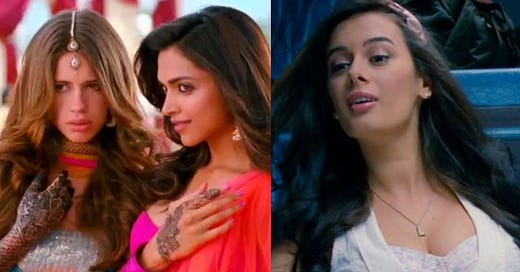Yeh Jawaani Hai Deewani & Fashioning the Ideal Indian Woman
How Deepika Padukone, Kalki Koechlin and Evelyn Sharma’s costume design informed the image of the perfect woman.
Yeh Jawaani Hai Deewani turned 10 years old couple of days ago and in the last decade, the rom-com has managed to live out quite an eventful legacy. From being a commercial and critical hit to going through a period of reexamination of how the film reinforces tired gender tropes, it's been quite a ride.
There’s a definite merit to the argument of how YJHD used established gender stereotypes and many great pieces have been written about that topic, so instead of repeating those arguments, I will be focusing on how the women in the film were represented through the lens of costume design.
The movie is about Naina Talwar (Deepika Padukone), a geeky introverted young woman who learns to come out of shell after she decides to go on a trekking trip with Aditi (Kalki Koechlin), Avi (Aditya Roy Kapur) and Kabir aka Bunny (Ranbir Kapoor), her former school classmates. On the trip, she falls in love with Bunny but since he wants to be a professional traveler, she restrains from sharing her feelings. Years later, they meet again at Aditi’s wedding and well, naturally both fall in love with each other.
Naina, as our female lead, is supposed to represent the ideal Indian woman. In the first half of the movie where she’s rather self-pitying and shy – when she’s notably wearing glasses – her modest femininity is represented through floral dresses often paired with light cardigans. Even while trekking, she wears miniskirts with rather impractical hairstyles which are then paired with boots and appropriate winterwear to showcase her personality that prioritizes comfort without letting go of style.
Her modesty is contrasted starkly by two characters – Aditi, who is a “tomboy” because she wears jeans/shorts, graphic tees, jackets and has short hair; and Lara (Evelyn Sharma) who is a “bimbo” that wears super short and tight clothing often in pink, wears hair accessories akin to a high school girl, speaks Hindi in a faux American accent and asks dumb questions.
Just through this visual representation, Naina’s style in the first half of the film falls perfectly between the “tomboy” and “bimbo” stereotypes. It’s no wonder that in the first half, Aditi also has an unrequited crush on Avi who doesn’t see her in the same way because she’s “one of the guys”.
8 years later, when everyone reunites at Aditi’s wedding (not with Avi), Naina’s costume design gives the appearance of a more sexually liberated woman who is not overt about that liberation. From wearing low necklines and figure-hugging kurtas to micro mini strapless choli, she exudes desire. Noticeably, she isn’t wearing her glasses (probably because glasses aren’t desirable?), but even more striking was that none of her outfits were non-Indian. Granted she’s at a wedding, but even her ‘day out in Udaipur’ look was a salwar-kurta which was again, sensuous enough to be appropriate without plunging into desperation. These choices could be read as her becoming more confident in herself and therefore her Indianness, but it can also be read as a comment by the storyteller who he considers to be the “heroine” and what that looks like.
Her moral character was again, contrasted through Lara who wears tight Indian clothing in a bright color, drinks alcohol with everyone and dances to ‘Ooh La La Tu Hai Meri Fantasy’ as opposed to Naina who only drinks alcohol with Bunny and planned on dancing to ‘Bole Chudiya’ - a much more tame and geeky choice.
But what was most striking was Aditi’s costume design in the second half. While her brash personality remains the same, her edgy “tomboy” attire is exchanged with rather traditionally feminine outfits like a black sparkly dress and Indian clothes that leaned more towards conservative style with conventional designs and colors. The difference is so stark that one wouldn’t be able to tell through her clothing that she has a rather fiery personality. It basically complements Naina’s style and again, that can read as a representation of their strong sisterly bond, but it is hard to overlook that in YJHD, a good morally upright Indian woman, who also has the male respect, looks a certain kind of way. She only wears modest clothing, doesn’t wear dark colors, has long hair, wears soft makeup, has a light complexion and a slim figure.
YJHD is a rom-com that has been successful in giving us fully fleshed out characters, but it is also rigid in its gender representation. Lara isn’t granted the courtesy of being a three-dimensional character. She is relegated to being a bimbo stereotype and instead used to uphold Naina and later, Aditi and the type of womanhood they inhabit. Unfortunately, this argument is made stronger when at one point, Bunny says to Naina that girls like Lara are made for flirtation, while girls like Naina are made for love. The message of who is a respectable woman and what she looks like is clear and that’s a shame.










Love the details! Your take on their styling is so on point.
Very very nice 👍